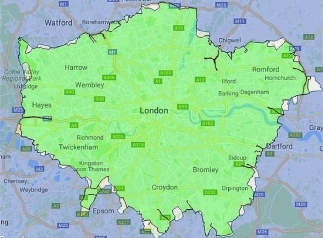The
T-charge is due to start in London in October 2017
In a news item
on the popular website petrolprices.com reviews the latest situation with the
planned introduction of a Toxicity Charge, or T-charge as it is known, in Central
London on 23rd October 2017 together with a legal challenge by FairFuelUK. News
item
The RAC also has a news item on the introduction of the T-charge.
RAC news
What
is the position with Historic cars?
Chris Hunt Cooke says "I can confirm
that vehicles in the Historic class have exemption from the T-charge, as well
as from the LEZ and ULEZ, provided they are not being used commercially".
Legal
trouble on the horizon for the T-charge
The report on the petrolprices.com
website says "FairFuelUK is seeking to raise a legal challenge against the
T-charge, arguing that a full public enquiry should have preceded the decision
to implement it. The challenge could have implications for every major UK town
and city. The organisation has described the Mayor of London’s decision to
implement this charge as unlawful and unfair. This is because FairFuelUK doesn’t
believe that drivers should be penalised for driving older petrol and diesel cars.
The campaigning organisation feels that a full public enquiry should have been
carried out before the decision to roll out the T-charge was made. FairFuelUK
has now launched a crowd funding campaign to raise money for a two-part legal
challenge against the T-charge. This would firstly see it ask the Mayor of London
to change his mind about introducing the T-charge. Secondly, it would ask the
Prime Minister and the Department for Environment, Food & Rural Affairs (Defra)
to investigate how else London could reduce pollution".
Posted:
170924 | Emissions
zones

Low
Emission Zone or LEZ in London
Find out if you would need to pay for you
vehicle
LEZ
checker
What is
the London Ultra Low Emission Zone or ULEZ?
As inner-city pollution worsens,
Low Emission Zones may become a key tool in helping authorities to control
emissions without the need for an outright ban on certain vehicles entering city
areas. They are predicted to become much more commonplace than today. The Ultra-Low
Emission Zone in London at present is due to come into force in September 2020
under proposals drawn up by the previous Mayor of London, Boris Johnson. It will
cover the same area as the London Congestion Charge zone so it will be more
focused on Central London than the existing Greater London Low Emission Zone.
Like
the LEZ, the ULEZ will operate 24 hours a day, including weekends and public holidays.
However, the ULEZ will also impose charges on all vehicle types (including cars)
for the first time – and the strictness of the emissions limits means that
potentially a large number of cars will be affected by it. The criteria for cars
is Euro 4 compliance for petrol models, meaning models built from 1 January 2006
will not be required to pay the ULEZ charge. For diesel models, the criteria is
much stricter: Euro 6 compliance is necessary, meaning only models built
from 1 September 2015 will be exempt from paying. The daily charge if cars don’t
meet the criteria is £12.50.
| New
T-charge soon
A new ‘T-Charge’ (toxicity charge) will
begin operating in Central London from the 23rd October 2017. The charge goes
live at a time of increased speculation about what other charges may soon be brought
in to other cities. The T-Charge will eventually be replaced by the Ultra-Low
Emission Zone, which is more expansive in geographical area and will have
stricter emissions standards, possibly as soon as 2019.
The T-charge will
operate within the boundaries of the existing London Congestion Charge zone. The
£10 T-Charge fee will however be on top of the existing £11.50 daily
congestion charge, which means non-compliant vehicles will have to pay £21.50
in total to drive in Central London on Monday to Friday between 7:00-18:00. The
T-charge is designed to improve London’s air quality by reducing the number
of higher polluting cars from entering the central London area. If you travel
regularly into London, any new ‘toxicity charge’ may have a big impact
on you, particularly if you drive an old petrol or diesel vehicle.
What
vehicles are affected?
Cars, vans, minibuses, buses, coaches and HGVs,
motorised caravans and horseboxes, breakdown and recovery vehicles, private ambulances,
motor hearses, dual purpose vehicles and other specialist vehicle types that do
not meet the minimum Euro emission standards are subject to the T-Charge. The
minimum emissions standards are Euro 4 vehicles. In general, this means
if your vehicle was registered before January 2005 you are likely to have to pay
the charge during the set times.
Euro
emission standards
How can I check if the T-charge will apply to
my vehicle?
Transport for London or TfL has produced a T-Charge checker
which allows drivers to input their number plate to check if they are liable to
the charge. To find out more widely what Euro Emissions standard category your
vehicle falls into, check when it was first registered.
T-charge
checker
Ways to future-proof yourself against the London T-charge
Park
outside the Congestion Charge zone or buy a post-2005 diesel car or buy an electric
car or buy a hybrid or range-extender. | T-charge
could be rolled out to other UK towns and cities
If the T-charge is a success
in London, it is thought that it will be rolled out to 25 other UK towns and cities.
These include Birmingham, Nottingham, Southampton and Derby, which will start
by charging older lorries, taxis and coaches by 2019. With legal issues against
the T-charge being raised before it has even been implemented, the future of the
charge is far from certain. However, one thing is for sure – urgent thought
needs to be put into how else pollution can be lowered in the UK’s major
towns and cities, whether this has to do with penalising certain motorists or
not. |
|




